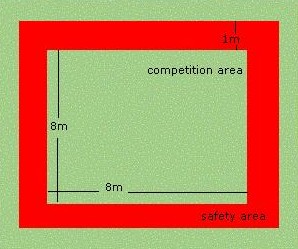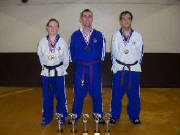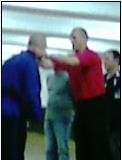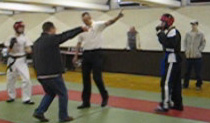|
How karate Competitions came about...
At first it was thought that there were too many styles of karate for there to
be an international karate competition. However, in 1964 an effort was made to draw up a standerised set of rules. The Federation
of All Japan Karate-do Organisation (FAJKO) was formed for this reason. Unfortunately progress was slow, but in 1970, when
other international organisations had started to appear on the scene, the first 'All styles' world championships were held
in Tokyo, Japan. Also during in 1970, a world governing body was established, the World Union of Karate-do Organisations.
A British association had been established in 1967. They went to Paris for the
second world championships in 1972, and were the first country to beat Japan in international competition. Since this occassion,
Great Britain has grown to be one of the worlds' leading karate nations.
Competition disciplines
When compeating the karate-ka has the choice of entering
either kata/form or fighting sections. Within these two categories there are countless different sections for example:
The competition area.
This can be elevated up to 1m above the floor but
if it is this high there must be a safety area of at least 2m around the perimeter. Often the area is flat to the floor
though.

Fighting
The area should measure 8m x 8m and be made up of
smaller mats placed together. It is the job of the referee to ensure that the mats do not seperate during a contest as this
could cause a serious injury.
The 1m saftey zone around the 'area' (shown
in red) does not count as a contest area and no points can be scored here. (However, if the attcker is within the area and
the deffender has one foot still in the area i believe any points scored will count).
Two markers in the centre of the mat are sometimes
placed to idicate where the fighters should stand when ready to fight. At this point, before the fight begins the fighters
stand 2m apart.
Kata
A kata competition can be performed on a mat (as above).
However, a wooden polished floor is better in my opinion(obviously free of splinters, and clean). There is no defined
size for this area but it must be large enough for the karate-ka to carry out their full routine at ease. For kata competiton the dress is a traditional karate Gi with the appropriate belt denoting the rank of the karate-ka.
Jamie Windle
1st place
kata (section 5th kyu - 2nd kyu)
x2 1st place fighting
2nd place team Fighting
Emma Wilcock
1st place Kata (section 2nd
kyu - dan grades)
1st place Pairs Kata with Jo Bolter
2nd place Fighting (womens semi-contact
points)
2nd place Team Fighintg
Adam Hawke
2nd
place Kata (Section 5th kyu - 2nd kyu)
|
NASSKC competition (December 2006)
|
| Team Sheffield Dec 06 |

|
Mark Huntington
2nd place Team Fighting
|
Jamie Windle
1st place
kata (section 5th kyu - 3rd kyu)
Emma Wilcock
1st place kata (section 2nd kyu - dan grades)
2nd place
Fighting (womens semi-contact points)
Adam Hawke
2nd
place Kata (Section 5th kyu - 3rd kyu)
|
Well done to everyone from sheffield that went to the competition (October 2006)
|
| Emma & Jamie |

|
| Adam Hawke |

|
|
|
| Well done Jamie Windle |

|
| 2nd place NASSKC fighting March 2005 |
|
Well done to everyone from sheffield
that went to the competition (March 2005)
|
| Well done Adam Hawke |

|
| 1st place NASSKC kata March 2005 |
|
|

